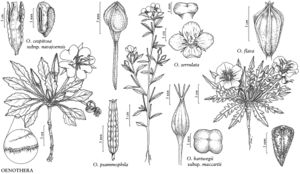Difference between revisions of "Oenothera psammophila"
Monogr. Syst. Bot. Missouri Bot. Gard. 12: 84. 1985.
imported>Volume Importer |
imported>Volume Importer |
||
| Line 57: | Line 57: | ||
|publication year=1985 | |publication year=1985 | ||
|special status= | |special status= | ||
| − | |source xml=https://xjsachs2@bitbucket.org/aafc-mbb/fna-data-curation.git/src/ | + | |source xml=https://xjsachs2@bitbucket.org/aafc-mbb/fna-data-curation.git/src/e39f0e846f172941159b2045254d62d10d9823f6/coarse_grained_fna_xml/V10/V10_18.xml |
|subfamily=Onagraceae subfam. Onagroideae | |subfamily=Onagraceae subfam. Onagroideae | ||
|tribe=Onagraceae tribe Onagreae | |tribe=Onagraceae tribe Onagreae | ||
Latest revision as of 10:31, 9 May 2022
Herbs perennial, caulescent, glabrous, also with resinous exudate, especially on younger leaves; from woody taproot. Stems decumbent, usually branched, 10–30 cm, becoming woody and buried in sand. Leaves (6–)8–9(–14.2) × (0.7–)1.5–2(–3.1) cm; petiole 3–9 cm; blade narrowly oblanceolate to oblanceolate, margins usually subentire or repand or remotely dentate, rarely serrate, apex acute. Flowers 1–3 per stem opening per day near sunset, with sweet scent; buds erect; floral tube 42–60 mm; sepals 22–28 mm; petals white, fading rose pink to rose, 23–40 mm; filaments 17–19 mm, anthers 13–16 mm; style 60–72(–88) mm, stigma exserted beyond anthers at anthesis. Capsules somewhat curved and often somewhat twisted, lanceoloid-cylindrical, nearly cylindrical, (20–)30–47 × 7–8 mm, gradually tapering to apex, 6–8 mm, dehiscent nearly throughout their length, valve margins with a conspicuous, irregular, wavy ridge; pedicel 1–5 mm. Seeds numerous, in 2 distinct rows per locule, narrowly obovoid, 2.5–3 × 1.2–1.4 mm, embryo 7/8 of seed volume, surface finely reticulate; seed collar with a broad membrane sealing cavity, margin entire. 2n = 14.
Phenology: Flowering May–Jul.
Habitat: On barren areas of drifting sand at interface between outcrops of lava and sand dunes.
Elevation: 1500–1700 m.
Discussion
Oenothera psammophila is known only from the dune area north and west of St. Anthony, Fremont County. It is unique in Oenothera because of the exudate produced on the leaves to which sand particles adhere, forming a sand sheath, presumably for protection from the constantly blowing sand particles. It is self-incompatible (W. L. Wagner et al. 1985; Wagner 2005).
Selected References
None.
